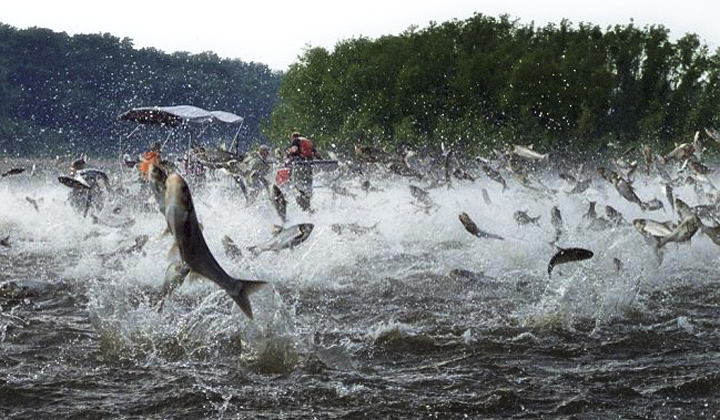JEFFERSON CITY, Mo. – In early September, hundreds of dead Asian carp lined the lake at St. Louis County Park. Dozens more turned up dead right across the Mississippi River in Granite City, Illinois yesterday – but no one is upset about it.
Asian carp are an invasive species brought into the Ozark area from China in the 1970s to improve water quality. The species has now spread to the Mississippi River and its tributaries, destroying or destabilizing many ecosystems in its path. The fish feed by rustling the bottom of the river up – where many native species lay their eggs.
The fish have become such a problem that the Obama Administration released an Asian Carp Control Strategy Framework in 2013. A new 5-year plan was released yesterday by the feds to improve the Great Lakes – it addresses pollution and Asian carp. Illinois Congressman Scott Dianda (D-Calumet) also introduced a resolution on Tuesday to address the carps’ potential impact on the Great Lakes.
Until this past year, the Missouri legislature had not made allocations for control of the species. A new line item of $500,000 for the Fisher Delta Research Center in Southeast Missouri with the purpose of funding a public private partnership for the control of Asian carp in Missouri was appropriated, vetoed, and left to die at veto session.
“The legislature decided that earmarks and special projects – things like Asian carp eradication – should get the first dollars in the door,” Gov. Jay Nixon said in a speech to the Cooperative Conference for School Administrators in July.
In fact, HB 2006, which appropriates funds for the Departments of Agriculture, Conservation, and Natural Resources, was not taken up by either chamber to override Nixon’s line item vetoes within the bill.
“The fiscal imbalance created by the General Assembly in enacting tax loopholes and exemptions without accounting for them in the budget, while at the same time adding funding for new government programs, must be corrected through my actions today to balance the state budget,” Nixon’s veto letter said.

However, Missouri departments, employees, and outdoor enthusiasts familiar with Asian carp don’t seem mad about the death of the funding. In fact, the Department of Conservation has two videos uploaded that attempt to promote the Asian carp as a food, as opposed to playing up how dangerous the species is to Missouri’s multi-million dollar fishing industry. Their website makes it clear that the fish are invasive, outlines the law in regards to some control of the fish, but goes far to market the fish to outdoor enthusiasts.
The videos, which are similar to one another, have over 78,000 views together. A department employee demonstrates how to filet and cook Asian carp, explaining how easy it is to filet a bone-in fish – which are less than popular among Missourians. The videos share that in a taste test, Asian carp was well favored among Missouri fish. Some outdoorsmen told The Missouri Times that the fish did not taste good, but are now considering Conservation’s recipes for their next encounter with a flying Asian carp.
“The solution is there must be some sort of harvest that must occur,” Quintin Phelps of the Missouri Department of Conservation says in the video.
Some Missouri fishers are less in love with the Asian carp, calling them “vile,” while some journalists who have encountered them recently dubbed them “the worst fish in America.”
“They’re not only destroying the ecosystem of every body of water connected with the river systems, they are also making traveling in a small vessel extremely dangerous,” Josh Gowan, a syndicated outdoor columnist from Sikeston, told The Missouri Times. “I received three stitches in my chin after taking a shot from a 7-pound carp, and I know countless fishermen who have been injured by them. They are vile creatures, and begin excreting slime and blood the second they land in your boat, and they flop with such violence it is nearly impossible to get them out immediately, so you just have to wait until they’re done trashing your boat.”
The Department’s marketing of the Asian carp as a fun meal may be a hard sell to McGowan.
“As to tasty, the meat is white and flaky, but the double-ribbed bone structure makes them very difficult to clean,” he concluded.
The report of the Granite City deaths came on the heels of a Vice News report on the Asian carp (Warning: strong language, alcohol, violent fish). One of their journalists examined the potential harm that the fish could have if they reach the Great Lakes, but perhaps most importantly, show live footage featuring fish flying out of the water and hitting the journalist leading the video.
Asian carp are a regular choice for alternative fishers because “fly” out of the water. The fish regularly land in boats and nets, but there are numerous tales of the fish hitting boaters and injuring them.
The flight and abundance of the fish allows 1-2 fishermen to catch over a ton of Asian carp a day, which is equating for some legitimate economic impact in Missouri. The Southeast Missourian reported last summer that fisheries had opened south of St. Louis with their eyes on the Asian carp. One fishery plans to use the fish for fertilizer, while other fishers and fisheries sell the fish for culinary purposes. Some of the larger fish sell for more because their cheeks are considered delicacies.
Missouri does not seem to have given up on controlling the fish based on the campaign to make the species appealing, and laws remaining on the books to limit the fish, which can get up to 48 inches long, but generally are 12-24 inches long. The fish have been recorded at being up to 50 lbs. Spawning is triggered by a rise in river levels, making Missouri a perfect place for the population to increase.
At the very least, Missourians can hope that a 50 lb Asian carp ends up on their plate and not their face.
Rachael Herndon was editor of The Missouri Times until 2019. She also produced This Week in Missouri Politics, published Missouri Times Magazine, and co-hosted the #MoLeg podcast. Herndon joined The Missouri Times in 2014, returning to political reporting after working as a campaign and legislative staffer. In 2019, she entered Missouri’s cannabis industry, co-founding Greenway Magazine.










